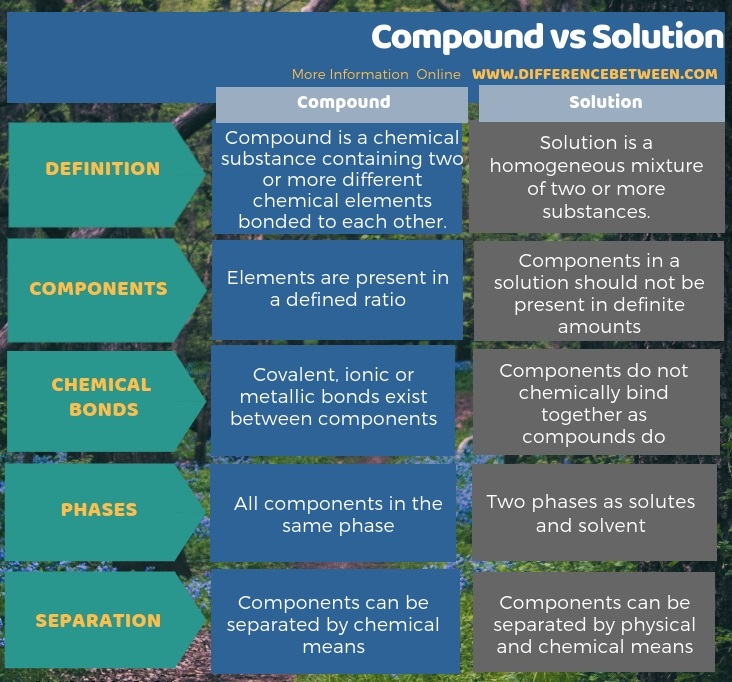The key difference between compound and solution is that a compound contains two or more elements that are chemically bound together whereas a solution has few substances that do not chemically bound together as compounds do.
Compounds and solutions are mixtures of elements or other compounds. The single elements are hardly stable under natural conditions. They form various combinations between them or with other elements in order to exist. When this happens, the properties of single elements vary and give rise to novel-to-novel mixtures.
CONTENTS
1. Overview and Key Difference
2. What is a Compound
3. What is a Solution
4. Side by Side Comparison – Compound vs Solution in Tabular Form
5. Summary
What is a Compound?
Compounds is a chemical substance containing two or more different chemical elements. However, we do not consider combinations of two or more of the same chemical elements as compounds; they are molecules, not compounds. For instance, diatomic molecules like O2, H2, N2 or polyatomic molecules like P4 are not compounds, but they are molecules. Some examples of common compounds are NaCl, H2O, HNO3, and C6H12O6.

Figure 01: A Molecule having more than One Chemical Element is a Compound
Therefore, compounds are a subset of molecules; thus, all compounds are molecules, but not all molecules are compounds. The elements in a compound join with each other via covalent bonds, ionic bonds, metallic bonds, etc. The structure of the compound gives the number of atoms in the compound and their ratios. In a compound, elements are present in a definite proportion. We can find these details easily by looking at a chemical formula of a compound. Moreover, the compounds are stable, and they have a characteristic shape, colour, properties, etc.
What is Solution?
A solution is a homogeneous mixture of two or more substances. We call it a homogenous mixture because the composition is uniform throughout the solution. The components of a solution are mainly of two types as solutes and the solvent. The solvent dissolves the solutes and forms a uniform solution. Therefore, normally solvent amount is higher than the solute quantity.

Figure 02: Different Solutions
Furthermore, all the particles in a solution have the size of a molecule or an ion. Thus, we cannot observe them by the naked eye. Also, the solutions can have a colour if the solvent or the solutes can absorb visible light. However, solutions are typically transparent.
Moreover, these mixtures can occur in a liquid, gaseous or solid state. But, most common solvents are liquids. Also, among liquids, we consider water as a universal solvent, because it can dissolve many substances than any other solvent. Besides, we can dissolve gas, solid or any other liquid solute in liquid solvents. However, in gas solvents, only gas solutes will dissolve.
There is a limit to the amount of solutes that we can add to a certain amount of solvent. When it reaches the maximum limit, the solution becomes saturated. But, if the amount of solute is very low, the solution becomes diluted. If there is a high amount of solutes in the solution, it is a concentrated solution. By measuring the concentration of a solution, we can get an idea about the amount of solutes in the solution.
What is the Difference Between Compound and Solution?
Compounds are chemical substances containing two or more different chemical elements bonded to each other. Whereas, a solution is a homogeneous mixture of two or more substances. Therefore, the key difference between compound and solution is that a compound contains two or more elements that are chemically bound together whereas a solution has few substances that do not chemically bound together as compounds do.
Moreover, in a compound, elements are present in a defined ratio, but in a solution, the components in it should not necessarily be present in definite amounts. Also, another vital difference between compound and solution is that we can separate the components in a solution by both chemical and physical methods, but we can separate the components in a compound by chemical means only.
The below infographic on the difference between compound and solution provides more details on these differences.

Summary – Compound vs Solution
Compounds and solutions are mixtures of chemical elements. The key difference between compound and solution is that a compound contains two or more elements that are chemically bound together whereas a solution has few substances that do not chemically bound together as compounds do.
Reference:
1. Helmenstine, Anne Marie, Ph.D. “Compound Definition in Chemistry.” ThoughtCo, Sep. 11, 2018. Available here
2. Helmenstine, Anne Marie, Ph.D. “Solution Definition in Chemistry.” ThoughtCo, Oct. 5, 2018. Available here
Image Courtesy:
1.”147356″ by OpenClipart-Vectors (CC0) via pixabay
2.”740453″ by MasterTux (CC0) via pixabay
ncG1vNJzZmivp6x7pbXFn5yrnZ6YsqOx07CcnqZemLyue8OinZ%2Bdopq7pLGMm5ytr5Wau26vzqanqK2emXqiusNmraxlo6S5tsDIqKVo